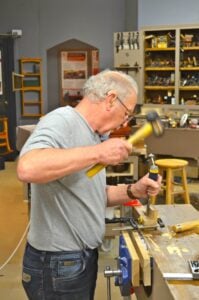The rhythmic success of mortise chopping
Today’s work meant chopping mortise holes, eight of them, for a table we are making in oak. It doesn’t take me but five minutes per hole to chop a 3/8” by 1 ¼” deep mortise 3” long, but it took us most of the day. Why is that? Well, here’s the reason:
Chopping mortise holes becomes rhythmic, a developed sense if you will. It occurs naturally in most people but lies dormant, inactive, undeveloped until its aroused by necessity. Not dissimilar to the way people feel that they can’t dance until they do it and at first it seems awkward but in minutes rhythmic movement becomes intrinsic, even inherent.

There are body issues in a unique language few people know or experience. It’s not the mere driving of a hammer-driven nail, which, though rhythmic too involves much less sensory perception. In our work, the chisels fights to twist, the wood resists, the hand counters and the arm too. 
The cross-grain chips lying on the bench tell their tale of order in making mortise holes; in the same way shavings on the woodshop floor speak of the plane’s set edge and sharpness, or the chips carved from the floral medallions the carver makes. I look for rhythm in the chopped out waste, even, full length segments unbroken as rhythm in its pulsing beat beats time in sound waves of air, in wood, in rock in air we breath and more beyond.


So there is someone else that uses the same type of registration guide when mortising.
It has worked well for me too. I use it occasionally – only for through mortises. Otherwise I just use one scribe line from my cutting gauge. It seems it is easier to just pay attention to one scribed/cut line and let the width of the chisel take care of the rest. If one is careful with the first set of shallow cuts and uses a good sharp chisel the mortise should be just as good as one scribed with two lines.
Alfred